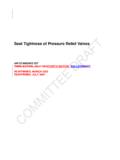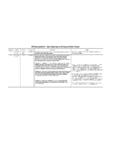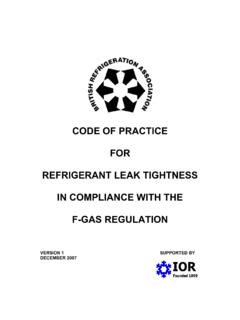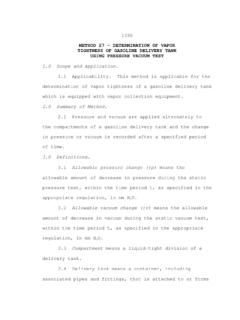Transcription of Pressure Testing for Strength and Leak Tightness
1 Page 1 Pressure Testing , April 2013, Cool Concerns Ltd Cool Stuff from Cool Concerns Pressure Testing for Strength and Leak Tightness This guide explains why systems are Pressure tested, and how to safely Pressure test using nitrogen. It also shows how to calculate the test pressures in accordance with EN3781. Systems are Pressure tested to ensure they are: Safe for this test a Pressure above the system s maximum allowable Pressure (PS) is used; Leak tight this test is at PS. The section at the end on test pressures shows how to calculate the pressures that are used for both of these tests.
2 Pressure Testing is hazardous and should be carried out carefully: The nitrogen used for Pressure Testing is an asphyxiant, so the area around the system should be well-ventilated; High pressures are used, so all non-essential personal should be evacuated from the area; Anyone carrying out the Pressure Testing should wear safety goggles. Nitrogen and regulation Dry (oxygen free) nitrogen (OFN) is used to achieve the pressures required for the Pressure tests because it is inert. You must never use oxygen for Pressure Testing - pure oxygen at high Pressure reacts violently with oil and will explode.
3 1 EN378-2:2008 Refrigerating systems and heat pumps Safety and environmental requirements, Part 2 Design, construction, Testing , marking and documentation. Using the nitrogen regulator 1. Ensure the regulator is closed (wound fully anti clockwise); 2. Open the cylinder valve; 3. Slowly open the regulator to the Pressure required. Do not use a regulator with an output Pressure much higher than you need. page 2 Pressure Testing , April 2013, Cool Concerns Ltd Cool Stuff from Cool Concerns You can also use nitrogen with a trace of either helium or hydrogen for the Pressure Testing (available from several suppliers).
4 Both helium and hydrogen have small molecules and leak at a lower Pressure than pure nitrogen. Leaks are detected using an electronic leak detector sensitive to either helium or hydrogen. Pressure test equipment The nitrogen cylinder should be connected to the system using a suitable Pressure Testing assembly with gauges and hoses suitable for the test Pressure . The photo shows a suitable Pressure Testing gauge / regulator assembly. If you are using a manifold ensure it is suitable for the Pressure and does not have a sight glass. You should use the gauge on the manifold to monitor the test Pressure (the gauge on the regulator has a very small scale).
5 Ensure the manifold valve is open before opening the nitrogen regulator. What to test You will not usually need to Pressure test components and assemblies which have already been tested by the manufacturer. Most of the time you just be checking interconnecting pipe work. If Rotolock valves are used to isolate components or assemblies be aware that they can pass nitrogen from the part of the system being pressurised into the isolated component. Make sure there are no isolated sections of the system / part of the system you are Testing , for example open solenoid valves using a permanent magnet.
6 The Pressure tests Increase the Pressure to approximately 5 bar g and check for leaks using leak detection spray at this Pressure initially many leaks will be identified at this Pressure so you will not waste nitrogen and time. It is also safer to find leaks at a lower Pressure than the final test pressures. Increase the Pressure slowly to the Strength test Pressure and hold it for 15 minutes. Under the Pressure Equipment Regulation this Strength test might need to be witnessed by a notified body. Reduce the Pressure to the Tightness test Pressure .
7 To complete the Tightness test you should either: page 3 Pressure Testing , April 2013, Cool Concerns Ltd Cool Stuff from Cool Concerns Check each joint with leak detection spray; or Hold the test Pressure for a period of at least 24 hours, checking that the Pressure has not dropped during this time. Note that if the ambient temperature changes by 5OC the nitrogen Pressure will change by bar. Therefore an increase in ambient could mask a drop in Pressure due to a leak. You should record the ambient temperature as well as the Pressure at the start and finish of the Tightness test.
8 When the system has been correctly Pressure tested you should vent the nitrogen to a well-ventilated area or outside. Repairing leaks If you find leaks during the Pressure Testing the nitrogen should be vented from the system before the leak is repaired. The joints should then be retested. Testing the high side and low side On most systems the high side is tested at a higher Pressure than the low side (exceptions include reverse cycle heat pumps and systems with saturated gas defrost - see next section on test pressures for full details).
9 Many low side components will not withstand the high side test Pressure , so either: The high and low sides need to be separated or the pipe work tested in stages as installed; or The entire system should be tested at the low side test Pressure . Most assemblies and components will have been Pressure tested by the manufacturer so you do not need to repeat this they can be isolated during the Pressure test. Pressure relief valves should also be isolated during the Pressure test as they will discharge at the Strength test Pressure . Test pressures EN378, part 2 provides guidance on the pressures to be used for Strength and Tightness Testing .
10 To calculate these pressures you need to determine the maximum allowable Pressure of the system (PS). High side PS PS depends on the maximum ambient temperature and the type of condenser. For the UK we usually use a 32OC maximum ambient. PS for the high side is found using the condensing temperatures listed in the table over the page for this ambient. The equivalent pressures for common refrigerants are also listed. For zeotropic blends the Pressure of the saturated liquid (also called the bubble point) is used. page 4 Pressure Testing , April 2013, Cool Concerns Ltd Cool Stuff from Cool Concerns Condenser type Maximum condensing temp.






